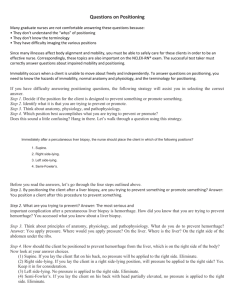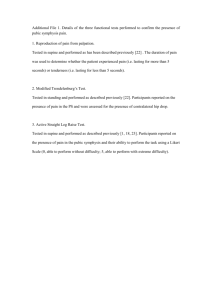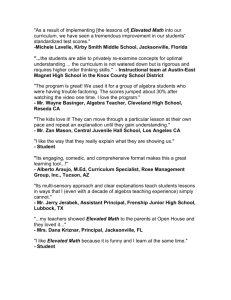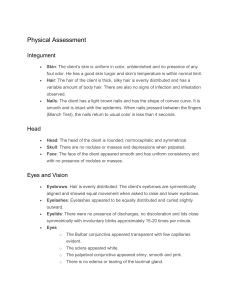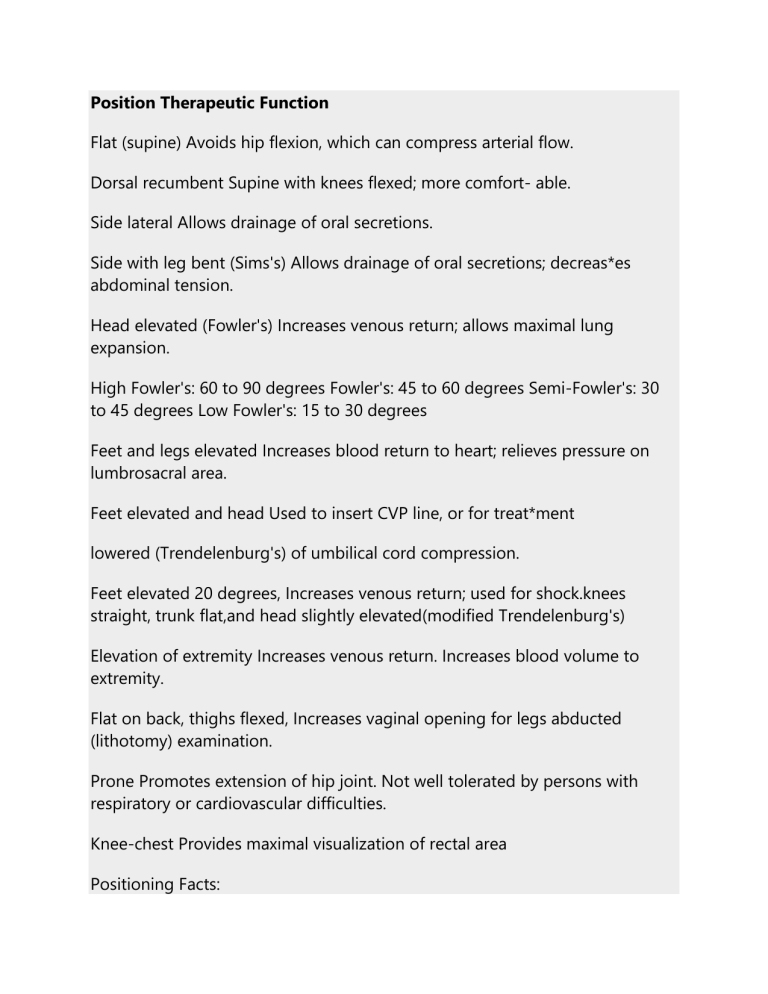
Position Therapeutic Function Flat (supine) Avoids hip flexion, which can compress arterial flow. Dorsal recumbent Supine with knees flexed; more comfort- able. Side lateral Allows drainage of oral secretions. Side with leg bent (Sims's) Allows drainage of oral secretions; decreas*es abdominal tension. Head elevated (Fowler's) Increases venous return; allows maximal lung expansion. High Fowler's: 60 to 90 degrees Fowler's: 45 to 60 degrees Semi-Fowler's: 30 to 45 degrees Low Fowler's: 15 to 30 degrees Feet and legs elevated Increases blood return to heart; relieves pressure on lumbrosacral area. Feet elevated and head Used to insert CVP line, or for treat*ment lowered (Trendelenburg's) of umbilical cord compression. Feet elevated 20 degrees, Increases venous return; used for shock.knees straight, trunk flat,and head slightly elevated(modified Trendelenburg's) Elevation of extremity Increases venous return. Increases blood volume to extremity. Flat on back, thighs flexed, Increases vaginal opening for legs abducted (lithotomy) examination. Prone Promotes extension of hip joint. Not well tolerated by persons with respiratory or cardiovascular difficulties. Knee-chest Provides maximal visualization of rectal area Positioning Facts: 1. Air/Pulmonary Embolism (S&S: chest pain, difficulty breathing, tachycardia, pale/cyanotic, sense of impending doom) --> turn pt to left side and lower the head of the bed. 2. Woman in Labor w/ Un-reassuring FHR (late decels, decreased variability, fetal bradycardia, etc) --> turn on left side (and give O2, stop Pitocin, increase IV fluids) 3. Tube Feeding w/ Decreased LOC --> position pt on right side (promotes emptying of the stomach) with the HOB elevated (to prevent aspiration) 4. During Epidural Puncture --> side-lying 5. After Lumbar Puncture (and also oil-based Myelogram)--> pt lies in flat supine (to prevent headache and leaking of CSF) 6. Pt w/ Heat Stroke --> lie flat w/ legs elevated 7. During Continuous Bladder Irrigation (CBI) --> catheter is taped to thigh so leg should be kept straight. No other positioning restrictions. 8. After Myringotomy --> position on side of affected ear after surgery (allows drainage of secretions) 9. After Cataract Surgery --> pt will sleep on unaffected side with a night shield for 1-4 weeks. 10. After Thyroidectomy --> low or semi-Fowler's, support head, neck and shoulders. 11. Infant w/ Spina Bifida --> position prone (on abdomen) so that sac does not rupture 12. Buck's Traction (skin traction) --> elevate foot of bed for counter-traction 13. After Total Hip Replacement --> don't sleep on operated side, don't flex hip more than 45-60 degrees, don't elevate HOB more than 45 degrees. Maintain hip abduction by separating thighs with pillows. 14. Prolapsed Cord --> knee-chest position or Trendelenburg 15. Infant w/ Cleft Lip --> position on back or in infant seat to prevent trauma to suture line. While feeding, hold in upright position. 16. To Prevent Dumping Syndrome (post-operative ulcer/stomach surgeries) -> eat in reclining position, lie down after meals for 20-30 minutes (also restrict fluids during meals, low CHO and fiber diet, small frequent meals) 17. Above Knee Amputation --> elevate for first 24 hours on pillow, position prone daily to provide for hip extension. 18. Below Knee Amputation --> foot of bed elevated for first 24 hours, position prone daily to provide for hip extension. 19. Detached Retina --> area of detachment should be in the dependent position 20. Administration of Enema --> position pt in left side-lying (Sim's) with knee flexed 21. After Supratentorial Surgery (incision behind hairline) --> elevate HOB 3045 degrees 22. After Infratentorial Surgery (incision at nape of neck)--> position pt flat and lateral on either side. 23. During Internal Radiation --> on bedrest while implant in place 24. Autonomic Dysreflexia/Hyperreflexia (S&S: pounding headache, profuse sweating, nasal congestion, goose flesh, bradycardia, hypertension) --> place client in sitting position (elevate HOB) first before any other implementation. 25. Shock --> bedrest with extremities elevated 20 degrees, knees straight, head slightly elevated (modified Trendelenburg) 26. Head Injury --> elevate HOB 30 degrees to decrease intracranial pressure
